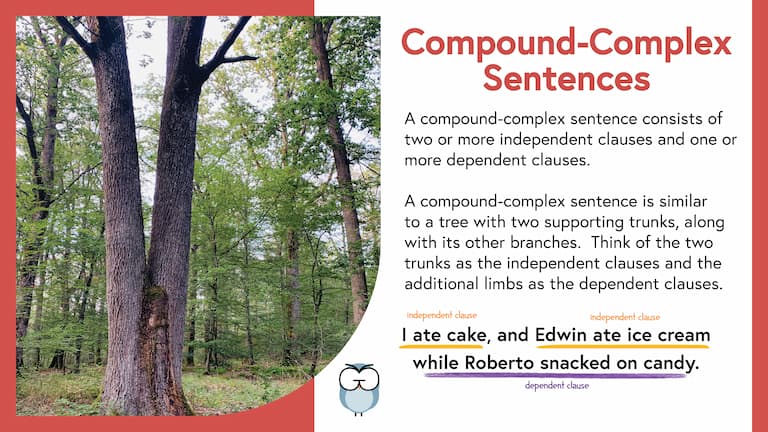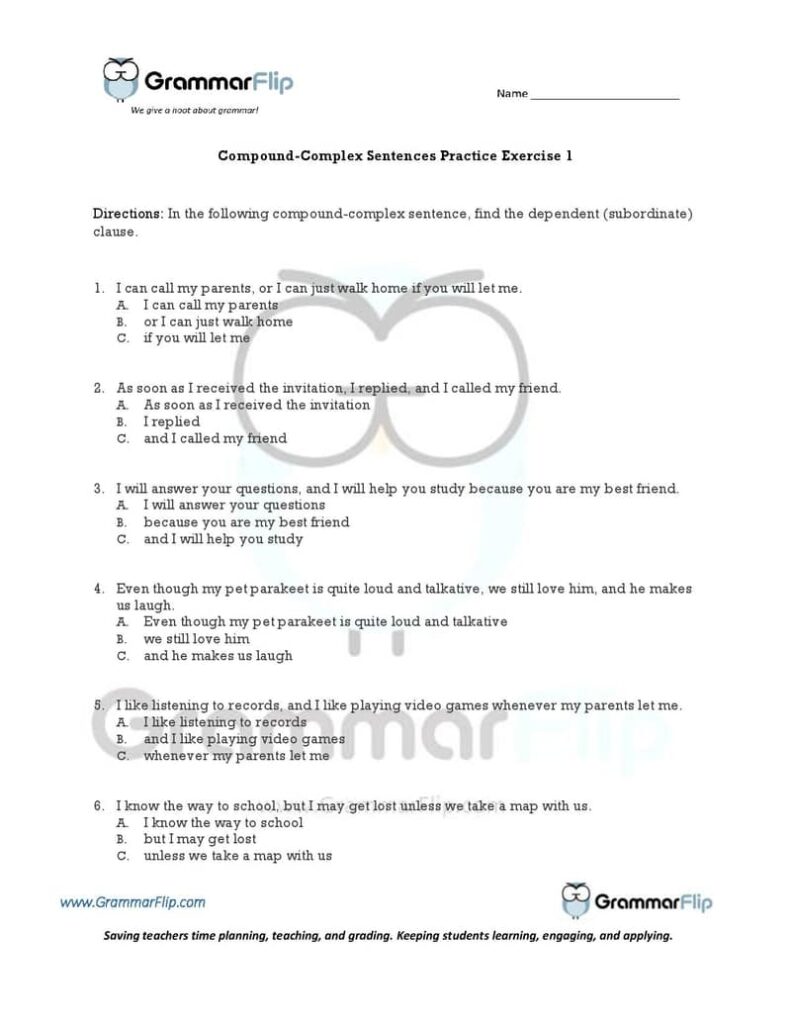What is a Compound-Complex Sentence?
A compound-complex sentence is a type of sentence that consists of two or more independent clauses and one or more dependent clauses.
Some examples of compound-complex sentences would be the following (note the italicized dependent clauses):
I invited Bruno to the concert, but he can only go if one of us gives him a ride.
Kaci has a bountiful vegetable garden, so she is always outside when it is sunny.
As soon as I heard the news, I called Nathan, and we made plans to celebrate.
I passed the test, but I would have gotten a perfect score if I had studied for the vocabulary section.
You can come pick up the cake, or if you would prefer, we can deliver it to you.
Long-Form Videos: Compound-Complex Sentences
Long-form instructional video lessons allow students to engage with grammar concepts in more depth and detail.
This format provides students with a stronger foundation and a more comprehensive understanding of compound-complex sentences.
Short-Form Videos: Compound-Complex Sentences
Short-form videos are an excellent way to review grammar concepts. Our two-minute instructional videos help students review the concept of compound-complex sentences to further solidify their understanding.
Memorable Images: Compound-Complex Sentences

The use of images to connect visual cues with concepts makes it simpler for students to grasp and remember key ideas. GrammarFlip’s memorable images create visual associations that make compound-complex sentences more engaging and easier to retain.
Definition Cards: Compound-Complex Sentences
Definition cards reinforce grammar concepts by providing clear and concise explanations that students can easily reference for quick review and better retention. GrammarFlip’s definintion cards help students review the concept of compound-complex sentences to further solidify their understanding.

Why You Should Use Compound-Complex Sentences in Your Writing
Using compound-complex sentences can enhance your writing in several ways:
Clarity and Variety: Compound-complex sentences allow you to express complex ideas more clearly. By combining independent clauses with dependent clauses, you can provide additional context or detail.
Flow and Coherence: These sentences create a smoother flow in your writing. They prevent monotony by varying sentence structure, making your text more engaging.
Sophistication: Employing compound-complex sentences demonstrates a higher level of writing skill. It shows that you can handle intricate sentence structures effectively.
When to Use Compound-Complex Sentences in Your Writing
Compound-complex sentences combine elements of both compound sentences and complex sentences, creating rich, intricate structures. Here’s when you might use them:
Nuanced Explanation: In academic writing or formal essays, compound-complex sentences allow you to provide nuanced explanations. They help you delve into complex ideas without sacrificing clarity.
Balancing Complexity: When you want to balance complexity and readability, these sentences come in handy. They add depth while maintaining a smooth flow.
Analytical Writing: In analytical writing (especially academic contexts), compound-complex sentences help represent intricate relationships and convey detailed information.
Download a Free Worksheet on Compound-Complex Sentences!
Click the image below to download your free GrammarFlip worksheet on compound-complex sentences!

Do your students use good sentence variety in their writing?
Explore More Lessons & Curriculum:
Parts of Speech lessons provide the building blocks of grammar. GrammarFlip covers these topics in detail to ensure a solid foundation is built. First time learners and students seeking to review the parts of speech can both benefit from the instructional videos and slide show reviews.
Parts of the Sentence lessons are critical for understanding how the parts of speech function in language construction. From the basic to the advanced, these lessons will cover a wide range of grammar topics that can be used in any grade level or classroom.
Mechanics and Usage lessons equip students with the necessary skills to communicate clearly to all audiences. With a focus on the application of these concepts in student writing, these lessons tie together both simple constructions of grammar as well as the more complex such that any age or skill level of student will benefit.


